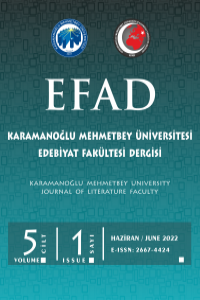Lynne Tirrell’in Anapher Teorisi’nin Metin Tahliline İlişkin Pratik Faydaları: Yakup Kadri Karaosmanoğlu’nun Hikâyeleri Örneği
Anapher, Lynne Tirrell, Yakup Kadri Karaosmanoğlu, metafor
The Practical Benefits of Lynne Tirrell's Theory of Anapher in Text Analysis: The Case of Yakup Kadri Karaosmanoğlu's Stories
Anaphora, Lynne Tirrell, Yakup Kadri Karaosmanoğlu, metaphor,
___
- Brandom, Robert B. (2000): Expressive Vernunft: Begründung, Repraesentation und diskursive Festlegung, Çev: E. Gilmer, H. Vetter, Suhrkamp, 1014 S.
- Duman, Mehmet Akif (2018): Von der Rhetorik zum belâgat, vom mecâz zur Metapher (Die Suche nach einer terminologischen Äquivalenz zum Begriff Der Metapher im Türkischen durch Vergleich von Rhetorik und belâgat), Berlin: Logos Verlag.
- Goethe, Johann Wolfgang (1994): West-östlicher Divan. Teil I ve II Frankfurt a. M.: Deutscher Klassiker Verlag.
- Hülzer-Vogt, Heike (1991): Kippfigur Metapher - metaphernbedingte Kommu¬nikationskonflikte in Gesprächen. Ein Beitrag zur empirischen Kommunika¬tionsforschung. Band 1: Gesprächsanalyse. Münster: Nodus Publikationen (= Studium Sprachwissenschaft, Beiheft 16).
- Karaosmanoğlu, Yakup Kadri (1914/ 1990): Bir Serencam, İstanbul: İletişim.
- Karaosmanoğlu, Yakup Kadri (1997): Hikâyeler, İstanbul: İletişim.
- Rolf, Eckard (2005): Metaphertheorien. Typologie. Darstellung. Bibliographie, Berlin/New York: de Gruyter.
- Tirrell, Lynne (1989): „Extending: The Structure Of Metaphor“. In: Noûs 23, Nr.1 (1989), S:17-34.
- Turbayne, Colin Murray ([1962]/1970): The Myth of Metaphor. Revised Edition. Columbia, South Carolina: University of South Carolina Press.
- Turbayne, Colin Murray (1970): The Myth of Metaphor, Reviewed Edition. Columbia, South Carolina: University of South Carolina Press.
- Weinrich, Harald (1963/1976/1996): „Semantik der Kühnen Metapher“, Zuerst erscheinen in: Deutsche Vierteljahrschrift 37 (1963), S.325-344; Sprache in Texten, Stuttgart: Klett-Cotta, S.295-316; in. Haverkamp, Anselm. Theorie der Metapher, Darmstadt: Wissenschaftliche Buchgesellschaft, S.316-339.
- Weinrich, Harald (1976): Sprache in Texten. Stuttgart: Klett.
- Weinrich, Harald (1980): „Metapher“. In: Historisches Wörterbuch der Philoso¬phie. Bd 5. Darmstadt: Wissenschaftliche Buchgesellschaft, S.1179-1186.
- Yayın Aralığı: Yılda 2 Sayı
- Başlangıç: 2018
- Yayıncı: Karamanoğlu Mehmetbey Üniversitesi
Roman Tekniği Bakımından Fahri Erdinç’in ‘Acı Lokma’ Romanı
Seyyid Eşrefuddîn Huseyin Gîlânî ve Şiirleri Üzerine
Osmanlı-Avusturya Sefaretnamelerinin Osmanlı Diplomasisi ve Modernleşme Süreci Üzerine Etkileri
Frankfurt Okulu ve Aydınlanma Eleştirisi
Uluslararası Geçmişten Günümüze Ermenek ve Çevresi Sempozyumu 02-04 Ağustos 2018
Dr. Erol Yüksel, Millî Mücadele’den 27 Mayıs’a Bir Siyasetçi: Refik Koraltan- Kitap İncelemesi
Romanla Kimlikleşen Bir Yüz: Halide Edib Adıvar ve Edebi Yaratımları
